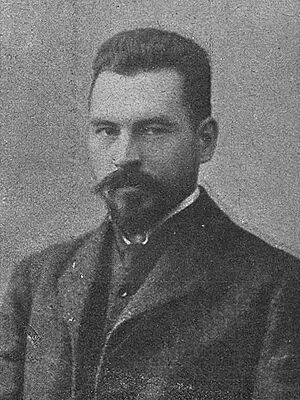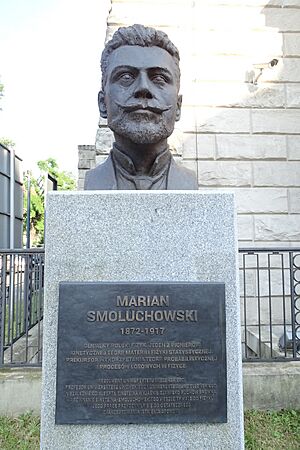Marian Smoluchowski facts for kids
Quick facts for kids
Marian Smoluchowski
|
|
|---|---|

Smoluchowski ca. 1913
|
|
| Born | 28 May 1872 Vorder-Brühl, Austria-Hungary
|
| Died | 5 September 1917 (aged 45) |
| Nationality | Polish |
| Alma mater | University of Vienna |
| Known for | Pioneering statistical physics Smoluchowski equation Smoluchowski coagulation equation Smoluchowski factor Einstein–Smoluchowski relation Feynman–Smoluchowski ratchet Helmholtz–Smoluchowski equation critical opalescence |
| Awards | Haitinger Prize of the Vienna Academy of Sciences (1908) Order of Polonia Restituta (1936) |
| Scientific career | |
| Fields | Physics |
| Institutions | University of Lviv Jagellonian University |
| Doctoral advisor | Franz S. Exner and Joseph Stefan |
| Doctoral students |
|
| Signature | |
Marian Smoluchowski (born May 28, 1872 – died September 5, 1917) was a brilliant Polish scientist. He was a physicist who lived and worked in the Austro-Hungarian Empire.
Smoluchowski was a pioneer in statistical physics. This field uses statistics to understand how tiny particles behave. He made big discoveries about Brownian motion and stochastic processes. Brownian motion is the random movement of particles in a fluid. Stochastic processes involve events that happen randomly over time.
He is famous for several important ideas and equations. These include the Smoluchowski equation, the Einstein–Smoluchowski relation, and the Feynman–Smoluchowski ratchet.
Contents
Life of a Scientist
Marian Smoluchowski was born in 1872 in a town called Vorder-Brühl, near Vienna. His family was well-known. He went to a very good school, the Collegium Theresianum. Later, he studied physics at the University of Vienna from 1890 to 1895.
Some of his teachers were famous scientists like Franz S. Exner and Josef Stefan. Another important physicist, Ludwig Boltzmann, returned to Vienna when Smoluchowski was in the army. Even though they didn't work together directly, Smoluchowski's ideas were similar to Boltzmann's.
After studying in Vienna, Smoluchowski worked at other universities. He spent time in Paris, Glasgow, and Berlin. In 1899, he moved to Lwów (which is now called Lviv). There, he became a professor at the University of Lwów. He also led the Polish Copernicus Society of Naturalists from 1906 to 1907.
In 1913, Smoluchowski moved to Kraków. He took over a leading position in the Experimental Physics Department. The professor before him, August Witkowski, had always hoped Smoluchowski would be his replacement.
When World War I started in 1914, working became very hard. The new, modern physics building was turned into a military hospital. This building was one of the main reasons Smoluchowski had moved to Kraków. He had to work and teach from the apartment of another professor, Karol Olszewski. It was almost impossible to do experiments during his lectures.
Smoluchowski taught experimental physics to many students. Some of his students included Józef Patkowski, Stanisław Loria, and Wacław Dziewulski. He was also a member of important scientific groups, like the Copernicus Society of Natural Scientists.
Sadly, Marian Smoluchowski died in Kraków in 1917. He passed away during an epidemic of dysentery. Professor Władysław Natanson wrote about him, remembering his kindness and modesty.
Smoluchowski's Scientific Work
Smoluchowski did very important research on the kinetic theory of matter. This theory explains how gases behave based on the movement of their tiny particles.
In 1904, he found out that the density of gas can change a lot in small areas. In 1908, he was the first to explain critical opalescence. This is a phenomenon where a substance becomes cloudy near a critical point. He showed it happens because of large changes in density. His work also helped explain why the sky is blue. It's due to light scattering in the atmosphere, known as Rayleigh scattering.
In 1906, he independently explained Brownian motion. This was around the same time Albert Einstein also explained it. Brownian motion describes the random movement of particles in a fluid.
Smoluchowski also created an equation that became a key part of the theory of stochastic processes. These processes deal with events that happen randomly over time. In 1916, he developed another equation for how things spread out (diffuse) in an electric field. This equation is named after him.
Personal Life
In 1901, Marian Smoluchowski married Zofia Baraniecka. She was the daughter of a professor at Jagiellonian University. They had two children: Aldona Smoluchowska and Roman Smoluchowski. Roman also became a famous physicist. He worked in Poland and later moved to the United States after World War II.
Outside of his scientific work, Smoluchowski had many hobbies. He loved skiing and climbing mountains in the Alps and the Tatra Mountains. He also enjoyed painting with watercolors and playing the piano.
Awards and Recognition

Marian Smoluchowski received many honors for his work.
- In 1901, he received an honorary doctorate from the University of Glasgow.
- In 1908, he won the Haitinger Prize from the Austrian Academy of Sciences. This was for his work on Brownian motion.
- In 1913, he was a special lecturer at Göttingen.
- In 1936, after his death, he was given the Commander's Cross of the Order of Polonia Restituta. This is a very high Polish award.
To honor his contributions, the Polish Physical Society created the Marian Smoluchowski Medal in 1965. This is an international award given for important achievements in physics.
In 1970, the International Astronomical Union named a crater on the Moon Smoluchowski after him. The Institute of Physics at the Jagiellonian University is also named after him.
Many streets in Polish cities are named Smoluchowski, including in Gdańsk, Lublin, Malbork, Kraków, Poznań, and Wrocław.
In 2017, the Senate of Poland declared it the "Year of Marian Smoluchowski." This was to celebrate the 100th anniversary of his death.
A famous physicist named Andrzej Kajetan Wróblewski said Smoluchowski was one of the greatest Polish physicists of the 20th century. He mentioned him alongside Marie Curie and others.
In 2022, a book called Zapomniany geniusz fizyki: rzecz o Marianie Smoluchowskim (The Forgotten Physics Genius: Marian Smoluchowski) was published. It tells the story of his life and scientific work.
See also
- Critical opalescence
- Electrophoresis
- List of Poles (physicists)
- Marian Smoluchowski Medal
- Timeline of Polish science and technology

